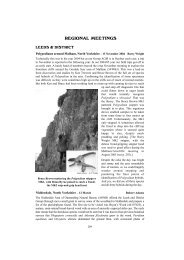Full Contents as pdf File - Natural History Museum
Full Contents as pdf File - Natural History Museum
Full Contents as pdf File - Natural History Museum
You also want an ePaper? Increase the reach of your titles
YUMPU automatically turns print PDFs into web optimized ePapers that Google loves.
animal/plant in less than one square kilometre) is attributed to the variety of habitats: cliffs,<br />
boulders, gravel and mud slopes, differences in exposure to the waves and a range of tidal<br />
currents. Peering into the clear water in between bouts of fern hunting, sea anemones and<br />
purple sea urchins were among the abundant sea-life visible.<br />
Walking along the north side of the Lough, we p<strong>as</strong>sed stands of bracken and Polystichum<br />
setiferum at the roadside, and clumps of Dryopteris affinis. We were puzzled already – w<strong>as</strong><br />
it subsp. affinis or subsp. cambrensis, or neither of these? Athyrium filix-femina and<br />
Asplenium adiantum-nigrum grew at the b<strong>as</strong>e of the rocky slopes. On the wall around the<br />
Lough w<strong>as</strong> more A. adiantum-nigrum, plus A. ruta-muraria, A. trichomanes subsp.<br />
quadrivalens and diminutive polypods, at le<strong>as</strong>t one of which w<strong>as</strong> convincing P. cambricum.<br />
Polystichum setiferum, Dryopteris filix-m<strong>as</strong>, D. dilatata, Asplenium scolopendrium, A. trichomanes<br />
subsp. quadrivalens and A. adiantum-nigrum were recorded on the roadside banks.<br />
The main re<strong>as</strong>on for our visit to Lough Hyne w<strong>as</strong> to see Asplenium onopteris, which used to<br />
be relatively common on roadside banks nearby. Unfortunately, the road appeared to have<br />
been widened and bramble growth had incre<strong>as</strong>ed. We did, however, add Blechnum spicant,<br />
Dryopteris aemula and D. affinis subsp. borreri to our list, and there were beautiful croziers<br />
of subsp. affinis. Lathyrus vernus (spring pea) and a pink form of Anthyllis vulneraria<br />
(kidney vetch) added colourful interest to the site.<br />
Roadside exploration in the opposite direction revealed more Blechnum and Dryopteris<br />
aemula, <strong>as</strong> well <strong>as</strong> an interesting Asplenium. It w<strong>as</strong> not convincing <strong>as</strong> A. onopteris, but on<br />
the other hand it didn’t match the A. adiantum-nigrum we had seen hitherto. Ken Trewren’s<br />
study of spores/chromosome count later revealed that it w<strong>as</strong> indeed A. onopteris.<br />
Some of us picnicked beside the Lough, making the most of the beautiful setting before the<br />
long drive back to Glengarriff. En route we admired stands of Osmunda regalis along<br />
roadsides and field boundaries.<br />
One of the most noteworthy features of Glengarriff Woods Nature Reserve w<strong>as</strong> the midges;<br />
application of insect repellent w<strong>as</strong> imperative. The area is well known for its saxifrages,<br />
including Saxifraga spathularis (St Patrick’s cabbage), but we were more interested in the<br />
filmy ferns growing on the same rocks. At one site (00/919568), where Hymenophyllum<br />
tunbrigense w<strong>as</strong> abundant and H. wilsonii w<strong>as</strong> also present, Ken found putative hybrid<br />
fronds with the colour and habit of H. wilsonii but with toothed indusial valves. These are<br />
the subject of ongoing research.<br />
We did the River Walk, a circular walk through the woods, which were predominantly sessile<br />
oak, with a lot of holly. Dryopteris aemula w<strong>as</strong> abundant, and D. affinis subspp. affinis and<br />
borreri, D. dilatata, D. filix-m<strong>as</strong>, Athyrium filix-femina, Pteridium aquilinum and Blechnum<br />
spicant were all noted. A possible hybrid between Dryopteris dilatata and D. aemula w<strong>as</strong><br />
found by Ken. Later examination of sporangia revealed many abortive spores but<br />
unfortunately a chromosome count w<strong>as</strong> not achieved; another sample is needed! Polypodium<br />
interjectum w<strong>as</strong> common, both on rocks and <strong>as</strong> an epiphyte. Osmunda regalis grew near the<br />
bridge over the river. A few more colonies of Hymenophyllum wilsonii were found on rocks by<br />
the river, in some c<strong>as</strong>es with H. tunbrigense growing above it. Asplenium trichomanes subsp.<br />
quadrivalens on the walls leading to a bridge near the car park completed our findings here.<br />
After dinner in Glengarriff we decided to hunt for Blechnum cordatum, which A Catalogue<br />
of Alien Plants in Ireland (2002) cites <strong>as</strong> naturalised in the area in 1952-3 and 1977. The<br />
B. cordatum eluded us, but the wonderfully ferny lane (north from 00/946567) w<strong>as</strong> home to<br />
Athyrium filix-femina, Blechnum spicant, Dryopteris affinis, Pteridium aquilinum,<br />
Equisetum arvense, Dryopteris dilatata, D. aemula, D. filix-m<strong>as</strong>, a large Osmunda regalis,<br />
Asplenium scolopendrium, A. trichomanes subsp. quadrivalens, A. adiantum-nigrum,<br />
Polystichum setiferum and Polypodium interjectum.<br />
90

















